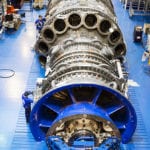Stricken by falling orders for large gas turbines, global technology conglomerate Siemens AG is reportedly moving to downsize its Power and Gas segment. The changes may include closure or sale of major sites globally and result in thousands of job cuts.
The company will likely embark on a reorganization plan this November that could result in the largest round of job cuts in two years, reported Bloomberg on October 19, citing unnamed sources. Reuters also reported on October 19, citing a “person familiar with the matter,” that “various scenarios are being considered” and that details of the overhaul are still being determined. German publication Manager Magazin is credited with first reporting on Thursday that 11 of 23 Siemens power and gas sites may be shuttered or sold.
“Please understand that we do not comment on rumors,” said Siemens spokesman Alfons Benzinger on October 19, responding to POWER’s request for confirmation of these reports.
Benzinger noted, however, that Siemens is systematically and successfully implementing its Vision 2020 strategy. “Among other things, we’re continually thinking about the right strategic setup for our businesses,” he said.
“This may include consolidating individual activities if market conditions make this necessary. At the same time, we’re investing heavily in growth fields—for example, energy management, the digitalization of industry, healthcare technologies and other related business areas—and thus in our future.”
Diminished Orders and Shrinking Profits
Siemens AG, headquartered in Berlin and Munich, is active in 200 countries and has 351,000 employees. According to the company’s 2016 annual report, its Power and Gas business employs 48,700 workers and accounts for about 20% of its revenue.
In an August 2017 analyst call centered on its third-quarter 2017 fiscal year earnings, while Chief Financial Officer Ralf Thomas said the company was “fully on track for another strong year,” he noted orders within its power and gas division had fallen “sharply”—by 41% compared to figures from the third-quarter of 2016.
Revenues for its Power and Gas business fell an estimated 11% during that same period (from €4.3 billion to €3.8 billion) owing mainly to declines in its large gas turbines and compression business. Profits also fell 23% stemming from “continued price pressure due to overcapacities.”
The Siemens Gamesa Renewable Energy arm wasn’t faring much better, and Thomas described a 64% fall in orders for its wind turbine manufacturing arm, mainly due to a temporary downturn in the Indian market. That entity, however, saw a 3% increase in revenues during that period.
The company will release its fourth-quarter results and preliminary figures on November 9, 2017.
Strong Foundations but a Shaky Future
Siemens, one of the world’s oldest power technology firms, was established in 1847. Its power sector footing was soundly established in 1866, when the company’s founder Werner von Siemens invented a new direct current (DC) dynamo-electric machine, which promised to reduce the weight of the drive unit by 85%, the necessary drive power by about 35%, and the price of the machine by 75%, all while maintaining the same power.
The discovery meant that electricity could be generated inexpensively and used at much higher capacities—making it one of the founding breakthroughs of the power sector’s history. [POWER, which this month marked its 135th anniversary, celebrated the Siemens milestone. For more, see: “History of Power: The Evolution of the Electric Generation Industry” in POWER’s October 2017 issue.)
Today, the company is one of the world’s largest suppliers of power generation, power transmission, and infrastructure solutions as well as automation, drive and software solutions for industry. It also provides medical imaging equipment.
But as sales from its power business have fallen, the company has picked up more business in the field of digitalization and sought to expand elsewhere. On September 27, Siemens signed a memorandum of understanding to combine its mobility business with Alstom’s rail traction drives business.
Alstom, once a giant power technology global player, sold its power business to General Electric (GE) in September 2015. However, GE’s power business, too, is seeing headwinds from a changing industry. While GE has moved to divest major divisions, the company is under pressure to cut costs.
“Over the decades, certain constants—such as internationality, a quality mindset and customer orientation—have remained guarantors of success,” Siemens said in an October 9 press release.
For Siemens AG President and CEO Joe Kaeser, the guiding principle behind Siemens’ changes lies in profitability. “Whatever we do must offer long-term benefits and generate value—for our shareholders, employees and customers as well as our business partners and society,” he said in the October 9 release.
—Sonal Patel is a POWER associate editor (@sonalcpatel, @POWERmagazine)









